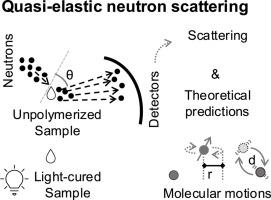光固化牙科材料中富氢物质的动力学
IF 4.5
2区 化学
Q2 POLYMER SCIENCE
引用次数: 0
摘要
牙科树脂复合材料主要由(二)甲基丙烯酸酯树脂和无机填料组成,它们的聚合反应是由光激活引发的。多年来,这些光固化材料的物理性能得到了改善,目前聚合动力学已经很好地建立起来。然而,在聚合物网络发育过程中,氢键形成的影响和分子迁移率的限制还没有完全阐明。在这里,我们能够探索富氢物质在光固化模型未填充树脂和树脂改性聚烯酸盐水泥中的动力学,通过光活化和准弹性中子能谱的独特组合,用于模拟弹性非相干结构因子(EISF)。这项实验研究不仅证实了单体在光活化下纳米迁移率的大幅降低,而且还描述了材料局部结构的变化。简而言之,光固化样品(树脂和水泥)的数据都是用单向各向同性旋转来描述的,这表明在平均时间内,分子没有优先取向。然而,在光激活之前,需要更复杂的动力学描述,包括构象跳跃,来解释未聚合材料的纳米级迁移性。显然,获得的关于光固化牙科材料纳米结构演变的新细节为该领域的进一步研究开辟了可能性。本文章由计算机程序翻译,如有差异,请以英文原文为准。


Dynamics of hydrogen-rich species in light-cured dental materials
Dental resin composites consist mainly of (di)methacrylate resins and an inorganic filler, and their polymerization reaction is initiated by light activation. Over the years, the physical properties of these light-curing materials have improved, and currently, the polymerization kinetics are well established. However, the influence of hydrogen bond formation and the restriction of molecular mobility during polymer network development is not fully elucidated. Here, we were able to explore the dynamics of hydrogen-rich species in a light-cured model unfilled resin and in a resin-modified polyalkenoate cement by means of a unique combination of light-activation and quasielastic neutron spectroscopy, which was used for modelling of the elastic incoherent structure factor (EISF). This experimental study not only confirms a substantial reduction in the nanoscale mobility of the monomers under light activation but also describes changes to the materials’ local structure. In brief, data from both light-cured samples (resin and cement) are described in terms of lone isotropic rotations, indicating that on a time average, the molecules have no preferred orientation. However, before light activation, more complex dynamical descriptions, including conformational jumps, were required to explain the nanoscale mobility of the unpolymerized materials. Clearly, the obtained emerging details on the evolution of the nanostructure in light-cured dental materials open possibilities for further advanced research in the field.
求助全文
通过发布文献求助,成功后即可免费获取论文全文。
去求助
来源期刊

Polymer
化学-高分子科学
CiteScore
7.90
自引率
8.70%
发文量
959
审稿时长
32 days
期刊介绍:
Polymer is an interdisciplinary journal dedicated to publishing innovative and significant advances in Polymer Physics, Chemistry and Technology. We welcome submissions on polymer hybrids, nanocomposites, characterisation and self-assembly. Polymer also publishes work on the technological application of polymers in energy and optoelectronics.
The main scope is covered but not limited to the following core areas:
Polymer Materials
Nanocomposites and hybrid nanomaterials
Polymer blends, films, fibres, networks and porous materials
Physical Characterization
Characterisation, modelling and simulation* of molecular and materials properties in bulk, solution, and thin films
Polymer Engineering
Advanced multiscale processing methods
Polymer Synthesis, Modification and Self-assembly
Including designer polymer architectures, mechanisms and kinetics, and supramolecular polymerization
Technological Applications
Polymers for energy generation and storage
Polymer membranes for separation technology
Polymers for opto- and microelectronics.
 求助内容:
求助内容: 应助结果提醒方式:
应助结果提醒方式:


